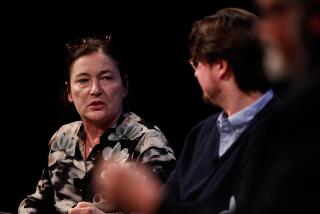Book review: ‘The Secret Lives of Somerset Maugham’ by Selina Hastings
The Secret Lives of Somerset Maugham
A Biography
Selina Hastings
Random House: 640 pp., $35
The story of William Somerset Maugham, the stammering young boy who became a doctor and then the world’s most famous writer since Dickens, has often been told, but in this new biography, “The Secret Lives of Somerset Maugham,” Selina Hastings draws upon previously unavailable material to create the fullest, most sympathetic portrait thus far. Hastings, while making her partiality toward her subject clear enough, writes with wit and offers a wealth of new detail. The achievement by the end (and the book is pretty hefty) is monumental, even if the starting point is familiar enough.
“On the Riviera, as in London and New York, Maugham, always elegantly dressed, looked every inch the conventional English gentleman. And yet conventional he was not,” Hastings writes. “In Maugham’s outwardly respectable life there was a great deal he was determined to keep hidden …”
Mostly, Hastings argues, this had to do with his sexuality. Maugham, as he confessed later in his life, was “75 per cent queer.” Today, no problem; but Maugham was born in 1874 and, as a young man, he witnessed the destruction of Oscar Wilde, whose plays he would later emulate with great success.
Because, as Hastings says, Maugham “liked sex and liked lots of it,” he needed secrecy and masks, at which he proved himself adept. Inside, however fabulous his outward worldly success became, he felt himself a threatened outsider, and therefore was a natural spy. He showed this skill when he acted for the British secret services during World War I in Switzerland and in Russia, which was then on the cusp of revolution.
“According to the elaborate code with which he had been equipped, Kerensky was to be identified as ‘Lane,’ Lenin as ‘Davis,’ Trotsky as ‘Cole,’ ” Hastings notes, “while the British government appeared under the guise of ‘Eyre & Co.’ ”
Maugham, a depressive who was capable of turning his cold eye upon himself, noted that he had no lyrical ability, no aptitude for metaphor and a distinct tendency toward cliché. He almost exclusively wrote from life, from observation, and he traveled endlessly to gather experience. His companion in the 1920s and 1930s, his professional heyday, was his great love, the American Gerald Haxton, a dissolute yet loyal chancer who wooed from strangers material that Maugham then used. By the time he met Haxton, however, Maugham was already married to Syrie Wellcome, the daughter of the Irish philanthropist Sir Thomas Barnardo. “The basic problem was twofold: the couple had almost nothing in common, and Syrie had made the fatal mistake of falling in love with her husband,” Hastings writes.
Syrie cajoled and trapped Maugham into marriage — and Hastings gives us the devious ins and outs as no previous biographer ever has. But this doesn’t quite let Maugham off the hook in the way Hastings argues. He knew his own nature; he knew too that marriage would provide convenient cover. A daughter, Liza, was born, and thus Maugham placed at the center of his life a time bomb that would explode decades later.
Meanwhile, with Haxton, Maugham moved into the Villa Mauresque, his splendid home on the French Riviera, surrounded by his modern art and his 9 acres of garden, attended by 13 servants, and went on writing bestselling novels and short-story collections that were staple fodder for the producers of Hollywood’s Golden Age. Some 98 films were made from Maugham’s material during his lifetime — “Rain” helped establish the career of Joan Crawford, while “Of Human Bondage” and “The Letter” provided Bette Davis with characters from which to shape her smart, ruthless screen persona.
A famous 1949 portrait by artist Graham Sutherland shows Maugham sitting in a straight-backed chair, arms crossed, wearing a velvet smoking jacket, his face lined and desiccated, surveying the world with a withering mouth and unblinking superciliousness. He looks like a mandarin, superb, decadent, merciless — quite untouchable. And at that time he was. Then came the hubristic fall. Haxton died and was replaced by another companion, Alan Searle. To prolong his vigor, Maugham took frequent trips to Switzerland, where he was injected with sheep fetus cells. Here was the sad farce of old age, but more serious damage was still to come. Manipulated and betrayed by Searle (“a podgy Iago,” writes Hastings), Maugham rewrote his will and tried to cut Liza out of it. Lawsuits ensued, along with worldwide acrimony.
The time bomb went off at last. Decades of wary plotting and carefully keeping the world at arm’s length exploded. As Gore Vidal has noted, Maugham built his own monument — and then blew it up. He published “Looking Back,” a vicious, ill-advised memoir, and slid into Alzheimer’s. Nothing grates like hate, and by the time Maugham died soon thereafter, in 1965 at age 91, the world had changed its view of the grandest of grand, old literary men. The man who had known “everyone, from Henry James to Winston Churchill, from Dorothy Parker to D.H. Lawrence” came to his sad end, raving like King Lear.
Hastings (unlike Ted Morgan in his 1980 hatchet job) doesn’t gloat over the decline, even while smacking the reader with its full horror. She’s also good on the happier era of Maugham’s ascent, and she places due emphasis on the genesis of Maugham’s masterpieces, the bildungsroman “Of Human Bondage” and “Cakes and Ale,” in which Maugham perpetrated an act of betrayal that would have shocked even James, and, as the critic Logan Pearsall Smith said, thrust in “the red hot poker that killed Hugh Walpole.”
Walpole, a minor English novelist, had been Maugham’s friend, but that cut no ice. Maugham was ruthless with himself and others when it came to writing. Great stylist he wasn’t, but his devotion to craft and mastery of narrative cunning were complete. The best of his work lasts, and new generations of readers go on to discover it — even the deliriously daft “The Razor’s Edge,” a story about the quest for ultimate meaning (Maugham believed there was none), still has a romantic appeal.
Another great English writer, Christopher Isherwood, described Maugham as “an old Gladstone bag, covered with labels. God knows what’s inside.” Hastings may not have unlocked all of Maugham’s secrets, and she can’t always make us like him, but she offers the most intimate, persuasive glimpse inside the old bag thus far.
Rayner is the author, most recently, of “A Bright and Guilty Place: Murder, Corruption, and L.A.’s Scandalous Coming-of-Age.”
More to Read
The biggest entertainment stories
Get our big stories about Hollywood, film, television, music, arts, culture and more right in your inbox as soon as they publish.
You may occasionally receive promotional content from the Los Angeles Times.










